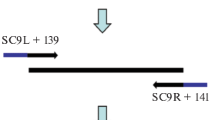Abstract
A straightforward real-time polymerase chain reaction (PCR)-based assay was designed and evaluated for the detection of Salmonella spp. in food and water samples. This new assay is based on the specific detection of the bipA gene of Salmonella, which encodes a protein of the guanosine triphosphate (GTP)-binding elongation family that displays global modulating properties, by regulating a wide variety of downstream processes. The new method correctly identified all 48 Salmonella strains used in the inclusivity test, and did not detect all 30 non-Salmonella species tested. The method was evaluated by analyzing 120 diverse food and water samples enriched in buffered peptone water. The bipA-based real-time PCR assay showed 100% efficiency, sensitivity, and specificity compared to the invA-based method previously published, which was developed as a part of a European project for the standardization of PCR methods in food microbiology. The assay includes an independent internal amplification control (IAC) in each reaction to control false negative results.
Similar content being viewed by others
References
Altschul SF, Madden TL, Schaffer AA, Zhang J, Zhang Z, Miller W, Lipman DJ (1997) Gapped BLAST and PSI-BLAST: a new generation of protein database search programs. Nucleic Acids Res 25:3389–3402
Anonymous. ISO 6539 (2000) Microbiology of food and animal feeding stuffs—horizontal method for the detection of Salmonella spp
Barker HC, Kinsella N, Jaspe A, Friedrich T, O’Connor CD (2000) Formate protects stationary-phase Escherichia coli and Salmonella cells from killing by a cationic antimicrobial peptide. Mol Microbiol 35:1518–1529
Chiu CH, Ou JT (1996) Rapid identification of salmonella serovars in feces by specific detection of virulence genes, invA and spvC, by an enrichment broth culture-multiplex PCR combination assay. J Clin Microbiol 34:2619–2622
Cohen HJ, Mechanda SM, Lin W (1996) PCR amplification of the fimA gene sequence of Salmonella typhimurium, a specific method for detection of salmonella spp. Appl Environ Microbiol 62:4303–4308
Farris M, Grant A, Richardson TB, O’Connor CD (1998) BipA: a tyrosine-phosphorylated GTPase that mediates interactions between enteropathogenic Escherichia coli (EPEC) and epithelial cells. Mol Microbiol 28:265–279
Friis C, Jensen LJ, Ussery DW (2000) Visualization of pathogenicity regions in bacteria. Genetica 108:47–51
Galan JE, Ginocchio C, Costeas P (1992) Molecular and functional characterization of the salmonella invasion gene invA: homology of InvA to members of a new protein family. J Bacteriol 174:4338–4349
Grant AJ, Farris M, Alefounder P, Williams PH, Woodward MJ, O’Connor CD (2003) Co-ordination of pathogenicity island expression by the BipA GTPase in enteropathogenic Escherichia coli (EPEC). Mol Microbiol 48:507–521
Hirose K, Itoh K, Nakajima H et al (2002) Selective amplification of tyv (rfbE), prt (rfbS), viaB, and fliC genes by multiplex PCR for identification of Salmonella enterica serovars typhi and paratyphi A. J Clin Microbiol 40:633–636
Hoorfar J (1999) EU seeking to validate and standardize PCR testing of food pathogens. ASM news 65,799. ASM News 65:799
Hoorfar J, Cook N, Malorny B et al (2003) Making internal amplification control mandatory for diagnostic PCR. J Clin Microbiol 41:5835
Lin CK, Tsen HY (1996) Use of two 16S DNA targeted oligonucleotides as PCR primers for the specific detection of salmonella in foods. J Appl Bacteriol 80:659–666
Malorny B, Hoorfar J, Bunge C, Helmuth R (2003a) Multicenter validation of the analytical accuracy of salmonella PCR: Towards an international standard. Appl Environ Microbiol 69:290–296
Malorny B, Tassios PT, Radstrom P, Cook N, Wagner M, Hoorfar J (2003b) Standardization of diagnostic PCR for the detection of foodborne pathogens. Int J Food Microbiol 83:39–48
Malorny B, Paccassoni E, Fach P, Bunge C, Martin A, Helmuth R (2004) Diagnostic real-time PCR for detection of salmonella in food. Appl Environ Microbiol 70:7046–7052
Mc Clelland M, Sanderson KE, Spieth J et al (2001) Complete genome sequence of salmonella enterica serovar typhimurium LT2. Nature 413:852–856
Miller JH (1972) Experiments in molecular genetics. Cold Spring Harbor Laboratory, Cold Spring Harbor, NY
Owens RM, Pritchard G, Skipp P et al (2004) A dedicated translation factor controls the synthesis of the global regulator fis. EMBO J 23:3375–3385
Pfennig PL, Flower AM (2001) BipA is required for growth of escherichia coi K12 at low temperature. Mol Genet Genomics 266:313–317
Qi SY, Li Y, Szyroki A, GilesI G, Moir A, O’Connor CD (1995) Salmonella typhimurium responses to a bactericidal protein from human neutrophils. Mol Microbiol 17:523–531
Rajewsky N, Socci ND, Zapotocky M, Siggia ED (2002) The evolution of DNA regulatory regions for proteo-gamma bacteria by interspecies comparisons. Genome Res 12:298–308
Rowe S, Hodson N, Griffiths G, Roberts IS (2000) Regulation of the escherichia coli K5 capsule gene cluster: evidence for the roles of H-NS, BipA, and integration host factor in regulation of group 2 capsule gene clusters in pathogenic E. coli. J Bacteriol 182:2741–2745
Thompson JD, Gibson TJ, Plewniak F, Jeanmougin F, Higgins DG (1997) The CLUSTAL_X windows interface: flexible strategies for multiple sequence alignment aided by quality analysis tools. Nucleic Acids Res 25:4876–4882
Tirado C, Schmidt K (2001) WHO surveillance programme for control of foodborne infections and intoxications: preliminary results and trends across greater Europe. J Infect 43:80–84
Yang Z, Nielsen R, Goldman N, Pedersen AM (2000) Codon-substitution models for heterogeneous selection pressure at amino acid sites. Genetics 155:431–449
Acknowledgments
Thanks are due to Jordi Batlle from the Laboratory of Microbiology of the Hospital Universitari Dr. Josep Trueta for providing some of the Salmonella strains used in this study. Laia Calvó is the recipient of a Beatriu de Pinós BP2005 fellowship from the Generalitat de Catalunya.
Author information
Authors and Affiliations
Corresponding author
Rights and permissions
About this article
Cite this article
Calvó, L., Martínez-Planells, A., Pardos-Bosch, J. et al. A New Real-Time PCR Assay for the Specific Detection of Salmonella spp. Targeting the bipA Gene. Food Anal. Methods 1, 236–242 (2008). https://doi.org/10.1007/s12161-007-9008-x
Received:
Accepted:
Published:
Issue Date:
DOI: https://doi.org/10.1007/s12161-007-9008-x




